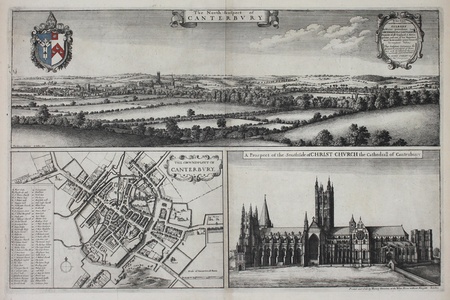| Method | Etching |
| Artist | Wenceslaus Hollar |
| Published | Tho: Iohnson delineavit, W: Hollar fecit. Printed and Sold by Henry Overton at the White Horse without Newgate, London. [c.1672] |
| Dimensions | Image 362 x 556 mm, Plate 375 x 568 mm, Sheet 500 x 615 mm |
| Notes |
A beautiful large scale composite plate showing a general view, city plan, and view of the cathedral of Canterbury. The general view, from the north, shows the Cathedral and city to the left, with forests and fields stretching out on all sides. Below, a birds-eye-view of Canterbury is closely based upon the inset map of the city published by John Speed for his county map of Kent in 1612. In the bottom right of the plate, a prospect of the south side of the Cathedral is shown. Both this and the general view of the city were engraved by Hollar after drawings by the local landscape painter, Thomas Johnson. In the top left, the arms of the Cathedral and City are impaled, and picked out in early wash colour. On the opposite corner, a lengthy dedication in an oval baroque cartouche reads: 'To his Grace the most Reverend Father in God Gilbert, by Divine providence Lord Archbishop of Canterbury, Primate of all England & Metropolitan, and one of his Majesties most honourable privy Councell, his munificent patron, This Sculpture, Containing the prospect & Groundplott of Canterbury with the Cathedrall thereof is most humbly presented and dedicated by Iohn Ogilby Esq. his Maj. Cosmographer.' The plate was most likely engraved by Hollar for his intended atlas of the British counties. This particular impression is the second state, printed by Henry Overton for the Nouveau Theatre de la Grande Bretagne. Overton's publication line can be found in the bottom right corner of the plate. Wenceslaus Hollar (1607-1677) left his native Prague in 1627. He spent several years travelling and working in Germany before his patron, the Earl of Arundel brought him to London in 1636. During the civil wars, Hollar fought on the Royalist side, after which he spent the years 1644-52 in Antwerp. Hollar's views of London form an important record of the city before the Great Fire of 1666. He was prolific and engraved a wide range of subjects, producing nearly 2,800 prints, numerous watercolours and many drawings. Thomas Johnson (c.1628-1685) was a British landscape artist, whose work is mostly known through the engravings of Wenceslaus Hollar. Johnson's paintings were predominantly architectural and landscape views of Canterbury and surrounds. Pennington 961 ii/iii Condition: Excellent, strong clean impression with full margins. Central vertical fold, as issued. Minor time toning to edges of sheet. |
| Framing | unmounted |
| Price | £1,400.00 |
| Stock ID | 51179 |

